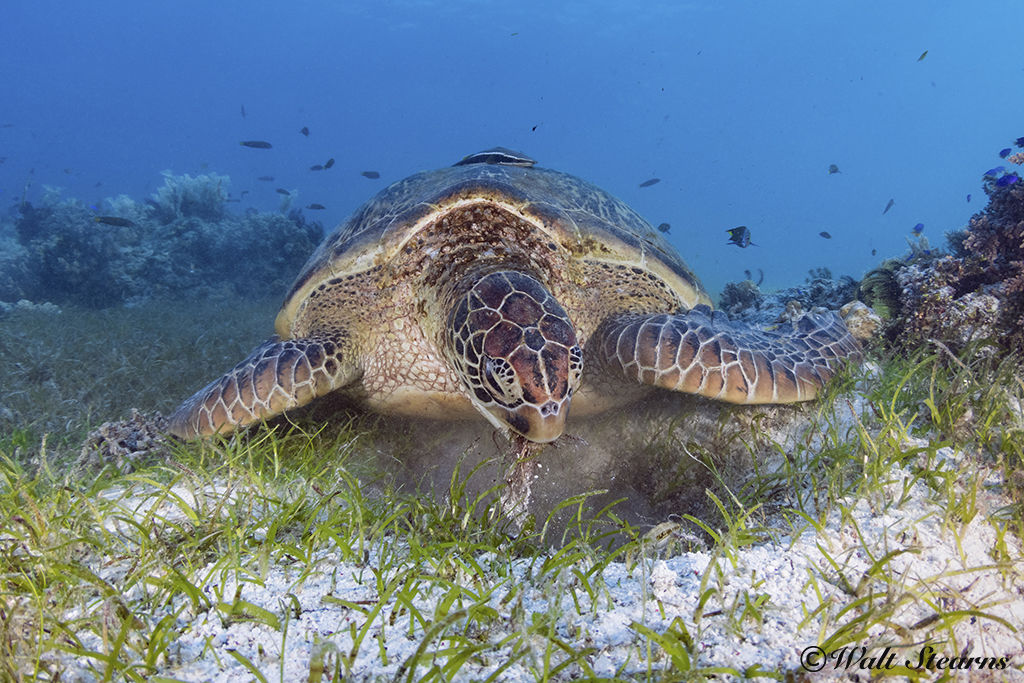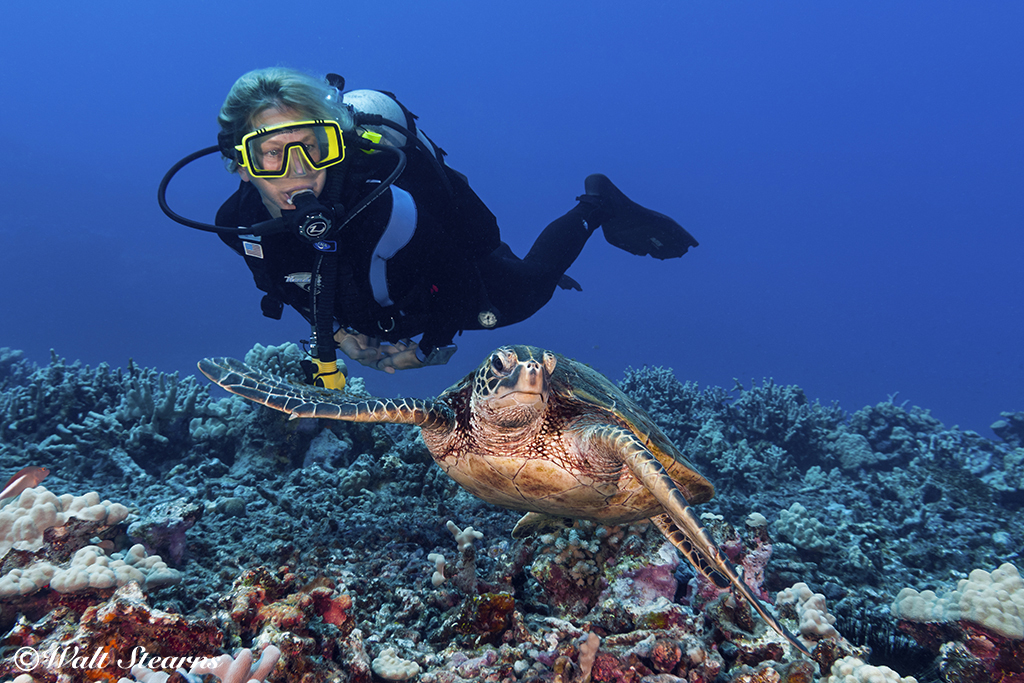
You've probably met them, but do you know them?
Sea turtle sightings make most any dive more interesting—especially if it's a big animal. Back on the dive boat, everyone will be saying things like “did you see the size of that one?” If the turtle in question was four or five feet long, you can chime in and state with confidence “Yep, biggest green I've ever seen.”
To make a similarly confident identification on a smaller specimen, you'll need to pay a bit more attention during the dive. Does the turtle's head look a bit like a parrot, with a beak-like nose? If so it's a hawksbill. Or, if the head seems unusually thick, like the end of a small log sticking out of the shell, go with loggerhead. Otherwise, it's a green.

They get around
Green turtles are widespread in tropical and sub-tropical waters around the world. They usually stick fairly close to shore, which increases the chances of interactions with snorkelers and divers. In the Caribbean and Atlantic, their shells are usually dirty white or yellowish, while populations in the Pacific and the Indian Ocean may tend towards a bluish-green shell color. Doesn't matter, they are all the same species—though some scientists think that a dark-shelled group found in the eastern Pacific might be a subspecies.

Underwater gardeners
Adult green turtles are vegetarians. After hatching, they will spend their early month's nibble on sponges, crabs and worms, but as they grow, they switch to algae and sea grass. Venture into the shallow waters of a seagrass meadow and you may find a green turtle noshing on the vegetation. And that's a good thing because their grazing is a benefit rather than a threat to the plants. Turtles don't just grab a mouthful of grass, they focus on the younger and more nutritious mid sections of the blades, while older and less nutritious top portions are bitten off and left to float free and drift away. This close cropping encourages new growth. Studies show that when turtles graze, they create a marked increase in the productivity and nutrient content of the grass bed. Without turtles, grass beds would suffer. Plants would overgrow and fill the sea floor with decomposing material that blocks nutrients from reaching roots, and promote the growth of slime molds.

Breath hold champions
Turtles are not amphibians. They are air-breathing reptiles with lungs, which mean they have to come up for air every so often. That said, they are world-class breath holders. An active turtle that is doing a lot of swimming and grazing may need to pop up every ten minutes to a half hour, but when they tuck under a ledge and nap, they can stay submerged for six hours or more. When a green turtle does surface, it doesn't have to spend much time prepping for the next dive, as it can replenish its air supply with a single strong exhalation and a full inhalation. These turtles have large lungs, which not only provide an ample reserve of oxygen; it also allows them to dive to greater depths without fear of lung collapse. Most of the time, greens stay in the 20 to 80-foot range, they are capable of diving to depths of 500 feet.

Growing up slow
Green turtles can reach sizes of up to 600-plus pounds, and only the rarely-seen leatherback grows larger. Big turtles are old turtles. After an initial growth spurt, greens grow at an average rate of fewer than two inches a year. It takes thoem around 20 years to get to the two-foot range, and if you happen across one with a shell larger than three feet in length, it's probably around 40 to 50 years old. These turtles also wait to mate, as they don't reach reproductive maturity until sometime in their late 30s to mid-40s. Once they enter the breeding population, female turtles become creatures of habit, traveling for distances of up to 1,000 miles to return the same beach each time they lay their eggs. Scientists haven't been tagging and studying green turtles long enough to gather conclusive evidence on life spans, but we know that these hard-shelled reptiles can live for at least 100 years if all goes right.

A little respect
When you see a turtle gliding along the reef, it's only natural that you'd want to fin over for a closer look, and maybe grab a photo. Nothing wrong with that, so long as you don't end up harassing the turtle. Most of the time, a green will ease along at about a mile an hour. But if they feel threatened, they can make short sprints of up to 20 miles an hour. And just as you'd be winded after a fast sprint, this escape behavior will tire the turtle and may force it to come up for air at an inconvenient time. The best way to approach a cruising turtle is to come along side and swim parallel, matching the animals swim pace and holding a position where the turtle can see you. This will send a message that you aren't pursuing, but are just heading in the same direction. After a few moments, you can begin to ease in closer while maintaining the same side-by-side position. Sometimes, you'll be able to get within a few feet, but if the turtle speeds up or veers off, let it go, and don't pursue. A different etiquette applies to resting turtles. They should be left alone. After all, no one likes to be woken up in the middle of a nap.
